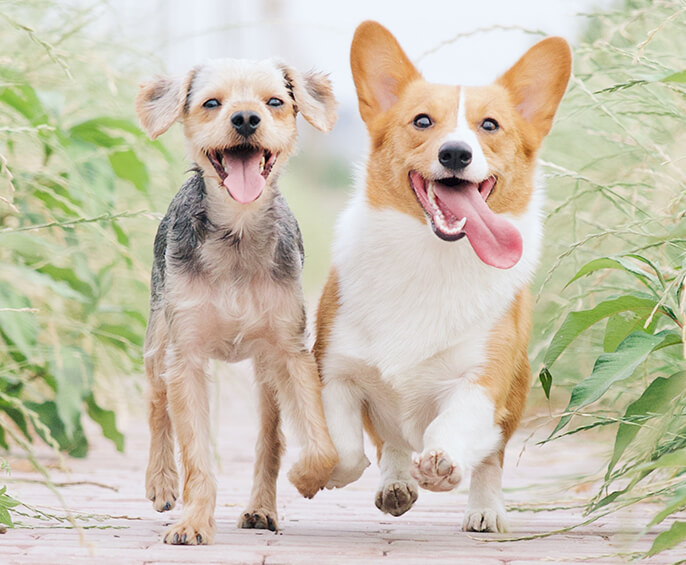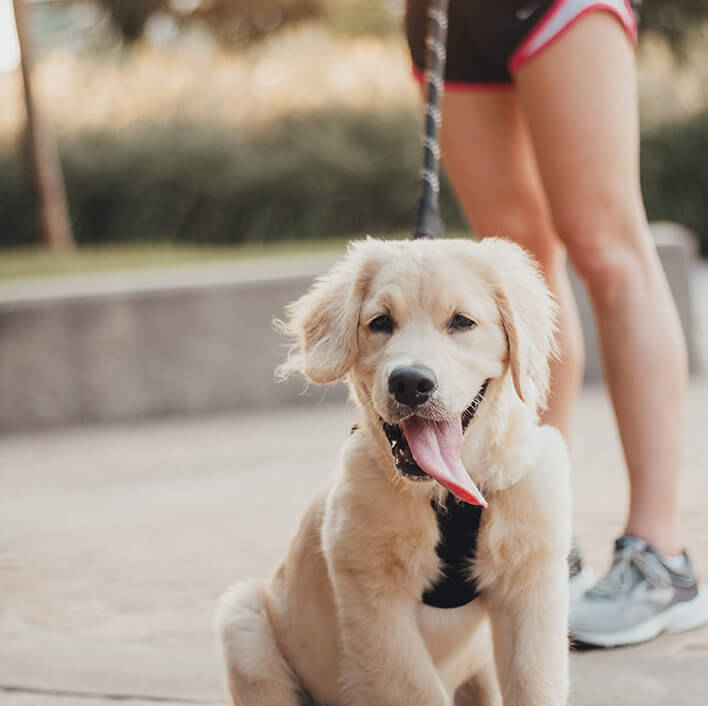Exercise is good for both us and pets. Exercise keeps us fit, clears our minds after a long day and helps your dog burn off excess energy. They are always up for an adventure! If you are looking for new ways to work out with your dog, then read our tips for the best dog exercises.

Exercise safely
Here’s a short note about how you can keep your dog safe when working out with him. Always follow the lead of your dog when it comes to how hard and intensely you exercise. Dogs can get overheated much faster than humans due to their shorter legs and fur coats. Watch out for these warning signs.
- Excessive panting
- The tongue is hanging out in a very long way
- The gums may be very pale or red.
- Vomiting, or diarrhea?
- You are lagging behind
- Does not want to exercise or go outside
- After-workout soreness
You should also take extra care to modify your exercise routines during summer and winter. Avoid the hotter times of day during the summer and opt for shorter, more intense workouts. If you’re too warm, your dog will be too. Place your hand on the sidewalk for 10 seconds to test. If you can, try to avoid areas that are snowy. You may also want to consider boots, or remove snow and ice from the paws of your dog after returning home.
1. Dog Walking
It’s the most popular dog activity, for good reason. You and your pet can both work out together at their own pace. Low-impact exercise is gentle for your joints and suitable for everyone, even overweight dogs or people who want to up their level of fitness.
Grab a cup of coffee to add some variety to your walk. You can also explore new neighborhoods. Let your dog enjoy a “sniff-walk”, taking as long as he likes to explore all of the different smells he encounters.
2. Running with your dog
Running with your dog can help you clear your mind and expend excess energy. Regular runs are especially beneficial for highly active breeds. Greyhounds, for example, may enjoy short interval sprints of training. Labrador Retrievers will probably prefer to jog alongside you.
Running can be very stressful on joints, so we recommend you wait until your dog is at least a year old before taking them for a walk. This is also not a great workout for obese dogs, or those who have arthritis. The flat-faced dogs (brachycephalics) should avoid running as well, because they might have breathing problems. Ask your vet for advice about whether your dog would benefit from jogging.
Keep an eye on your dog for signs of fatigue or excessive heat. You may also want to keep your dog on a lead, depending on their retrieve ability and on the conditions you are running in. You may find a hands-free harness useful.
3. Walking with your dog
You and your pet can both benefit from hiking with each other. It is a great form of exercise that you can tailor to your fitness level. This is a fantastic cardio exercise that strengthens your core and improves your balance. It also builds strength across a range of muscles. It is proven that getting closer to nature, taking in its beauty and absorbing it can help to boost your mood and combat stress.
Start your dogs off on shorter walks in easier terrain. This will help to build their confidence. Once your dog is comfortable, you can gradually increase the difficulty of steep hills or uneven terrain. Consider taking your dog in a carrier if you have a smaller or younger pup.
4. Swim with your dog
Swimming is a great exercise for dogs who enjoy the water. Swimming is a great whole body workout for your dog that will take the strain off their joints. This makes it perfect for senior dogs or pets with arthritis.
Some dogs, like the Nova Scotia Duck Tolling Retriever were bred for water activities, but others might find the experience difficult. They may also not know how to swim instinctively. We recommend a dog life jacket until you are confident that they will be comfortable. Life vests can be especially helpful for breeds with long bodies, such as Dachshunds or those that have a specific weight distribution.
As long as you take some precautions, your dog can enjoy a swim in a backyard pool, a lake, or the ocean. You should always provide your dog with plenty of drinking water to ensure they do not drink chlorinated water or seawater. Avoid lakes that contain blue-green alga, as it is poisonous for dogs. Also be aware of strong currents and rip tides on the beach. You should also make sure that your dog does not ingest any beach sand, which can cause a life-threatening obstruction or gastrointestinal impaction.
It’s better to limit swim time to 10-15 minutes to avoid your dog becoming overheated, tired or ingesting water. Throwing large toys into the water can cause your dog to accidentally swallow water when retrieving them. Frisbees and other flat, smaller toys are better options. To avoid infection, make sure to dry off your dog completely after they come out of water. Pay special attention to their skin folds or ears.
5. Doing doga (dog yoga)
Dog yoga is a fun way to bond with your dog while working out. Add some easy-to-copy poses to your workout routine to encourage your dog to remain close by. The pose that your dog may be more comfortable with is downward dog.
Ask your dog to lay next to you during Savasana and then stroke him as you both relax. It has been proven that stroking your dog releases ‘happy chemicals’ such as oxytocin serotonin dopamine in you both. These are chemicals which help us relax and calm down.
6. Dogs can learn to do circuit training
It’s a great way to work out with your dog. You can modify it to fit any fitness level or to accommodate an injury. You can choose a variety of exercises to include in your circuit such as lunges and planks. Ask your dog for a paw every time you do squats. When you do a plank or wall sit, your dog may want to mimic the movements. For example, when doing a downward dog, have them hold it too. You could pick up your small dog and give it a hug instead of dumbbells.
Mental stimulation can be a great way to boost your dog’s mood and fight boredom. Take the time to review your dog’s tricks and commands while you are exercising. This will make your pooch happier.
7. Doing dog agility
Agility is one of the most popular ‘dog games’ for active dogs. The obstacle course includes items like a weave pole, seesaw, and tunnel that the dog has to navigate under your supervision. You will also get a good workout by keeping up with your dog as they run around the agility course.
Agility is a sport that almost all breeds can enjoy. While intelligent and highly-active breeds like Border Collies or Australian Shepherds excel in agility, you might need to adapt some obstacles. Consider giving agility a try if your dog enjoys running, jumping and learning new tricks.
Numerous local clubs across the nation offer classes and taster sessions. Search the AKC Club Database to find a local club. You can also set up an agility course using household items in your yard. For more information, read our article How to Teach Your Dog Agility.
8. Frisbee game with dog
Frisbee can be a great way to exercise your dog and you, too. As you throw it while running, you will also get some cardio benefit. Team up with friends to play Ultimate Frisbee, a dog-human game that will add some variation to the usual fetch.
You might want to enter your dog in ‘Disc Dog events’ if they are a master at catching the Frisbee from a distance. These events are hugely popular in the United States, and there are even competitions for novices as well as experienced competitors.
9. Dance with your Dog
Canine Freestyle is another dog sport that’s popular across the country. Freestyle is a dog sport where you perform with your pet a routine that includes tricks to make it appear as if you are dancing. You can do heeling, weave, pawwork, jumps, and much more.
Dog dancing can be tailored exactly to the physical capabilities of your dog. You can leave out tricks that are difficult for them, such as jumps and other tricks with high impact. To keep the choreography fun, you can choose tricks they enjoy and excel at.
Working out with Your Dog
Exercise with your dog can help you both stay fit and healthy while strengthening the bond between human and dog. This is a great way to boost your mood and provide mental and physical stimulation for both you and your dog. It also reduces boredom levels and unwanted behaviors within the home. It’s also a lot of fun for both you and your dog! This article should have inspired you to find a new exercise with your dog. Speak to your vet if you are unsure of how much exercise or the type that is best for your dog. Your veterinarian can give you advice on what limitations and adaptations to make in order to keep your pet safe while working out.

